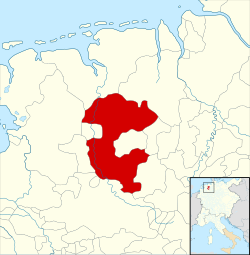County of Tecklenburg
| County of Tecklenburg | ||||||||||
| Grafschaft Tecklenburg | ||||||||||
| State of the Holy Roman Empire (until 1806) | ||||||||||
|
||||||||||
|
County of Tecklenburg around the middle of the 13th century
|
||||||||||
|
County of Tecklenburg with Rheda about 1560
|
||||||||||
| Capital | Tecklenburg | |||||||||
| Languages | West Low German | |||||||||
| Government | County | |||||||||
| Historical era | Middle Ages | |||||||||
| • | Established | early 11th century | ||||||||
| • | To counts of Schwerin | 1327–1557 | ||||||||
| • | Partitioned to create the County of Lingen |
1493 |
||||||||
| • | To Solms-Braunfels by judgement |
1696 |
||||||||
| • | Sold to Brandenburg | 1707 | ||||||||
| • | Mediatised to Berg | 1808 | ||||||||
| • | Annexed by France to form département of Lippe |
1810–15 |
||||||||
|
||||||||||
The County of Tecklenburg (German: Grafschaft Tecklenburg) was a state of the Holy Roman Empire, located in the present German state of Lower Saxony.
In the 12th century the county of Tecklenburg emerged in the region that is now called the "Tecklenburger Land" in the western foothills of the Teutoburg Forest.
Following the extinction of the counts of Tecklenburg in 1262, it was annexed by the neighbouring County of Bentheim in 1263. Between 1328 and 1562 it was ruled by the Counts of Schwerin. In 1365 they acquired the Lordship of Rheda, but in 1400 they lost the northern parts of the county with the districts of Cloppenburg, Friesoythe and Bevergern to the Prince-Bishopric of Münster.
Conrad of Tecklenburg-Schwerin was the first ruler in Westphalia to introduce the Reformation and became a member of the Schmalkaldic League. Following the defeat of the League, the county of Tecklenburg was forced to cede territories to Charles V to form the County of Lingen. In 1557, in conflict with the claims of the House of Solms-Braunfels, the county was inherited by Arnold II (IV) of Bentheim-Tecklenburg whose son Adolf founded a new line of counts of Tecklenburg. In 1588 the counts introduced calvinism to Tecklenburg.
...
Wikipedia



